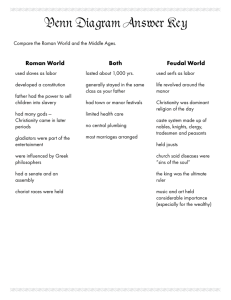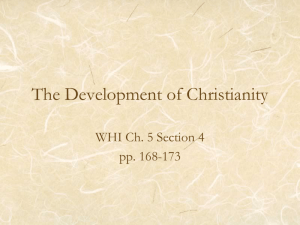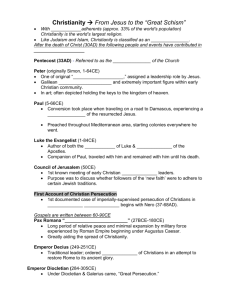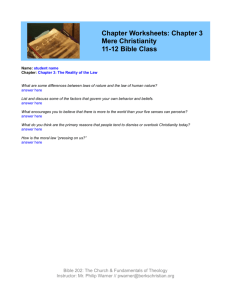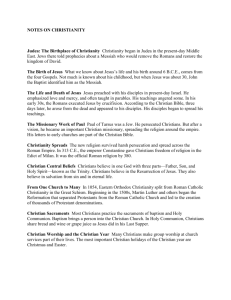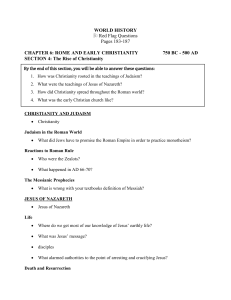Background of the New Testament and Christianity: Jesus was born
advertisement
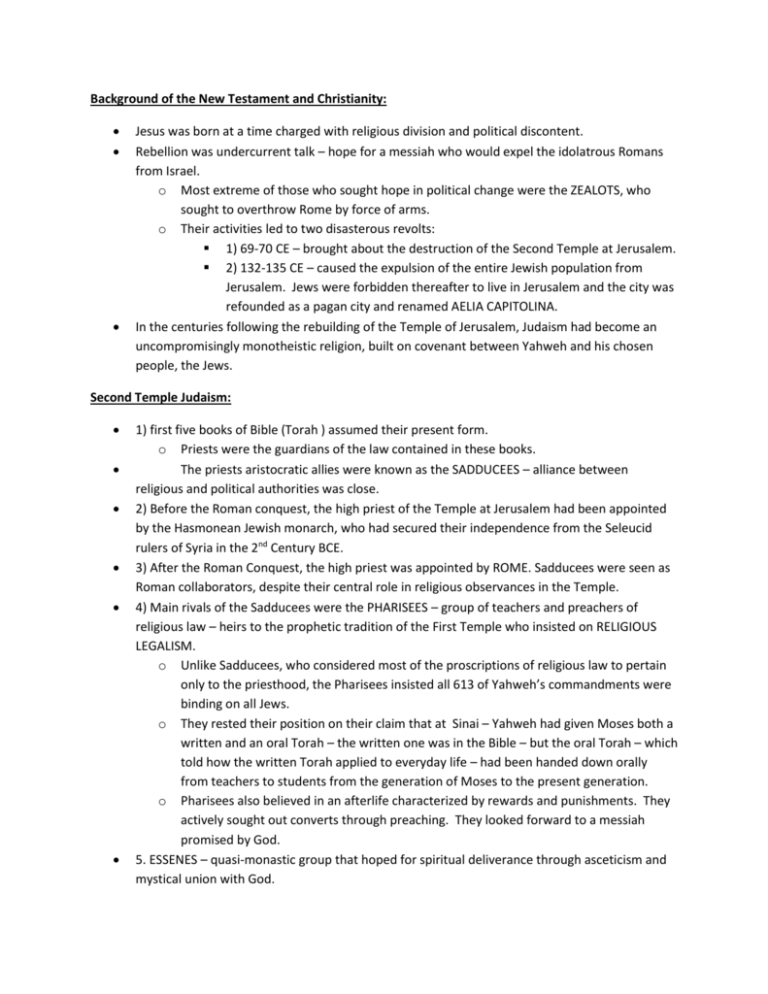
Background of the New Testament and Christianity: Jesus was born at a time charged with religious division and political discontent. Rebellion was undercurrent talk – hope for a messiah who would expel the idolatrous Romans from Israel. o Most extreme of those who sought hope in political change were the ZEALOTS, who sought to overthrow Rome by force of arms. o Their activities led to two disasterous revolts: 1) 69-70 CE – brought about the destruction of the Second Temple at Jerusalem. 2) 132-135 CE – caused the expulsion of the entire Jewish population from Jerusalem. Jews were forbidden thereafter to live in Jerusalem and the city was refounded as a pagan city and renamed AELIA CAPITOLINA. In the centuries following the rebuilding of the Temple of Jerusalem, Judaism had become an uncompromisingly monotheistic religion, built on covenant between Yahweh and his chosen people, the Jews. Second Temple Judaism: 1) first five books of Bible (Torah ) assumed their present form. o Priests were the guardians of the law contained in these books. The priests aristocratic allies were known as the SADDUCEES – alliance between religious and political authorities was close. 2) Before the Roman conquest, the high priest of the Temple at Jerusalem had been appointed by the Hasmonean Jewish monarch, who had secured their independence from the Seleucid rulers of Syria in the 2nd Century BCE. 3) After the Roman Conquest, the high priest was appointed by ROME. Sadducees were seen as Roman collaborators, despite their central role in religious observances in the Temple. 4) Main rivals of the Sadducees were the PHARISEES – group of teachers and preachers of religious law – heirs to the prophetic tradition of the First Temple who insisted on RELIGIOUS LEGALISM. o Unlike Sadducees, who considered most of the proscriptions of religious law to pertain only to the priesthood, the Pharisees insisted all 613 of Yahweh’s commandments were binding on all Jews. o They rested their position on their claim that at Sinai – Yahweh had given Moses both a written and an oral Torah – the written one was in the Bible – but the oral Torah – which told how the written Torah applied to everyday life – had been handed down orally from teachers to students from the generation of Moses to the present generation. o Pharisees also believed in an afterlife characterized by rewards and punishments. They actively sought out converts through preaching. They looked forward to a messiah promised by God. 5. ESSENES – quasi-monastic group that hoped for spiritual deliverance through asceticism and mystical union with God. o Some Essene influence on the career of Jesus, but in most respects Jesus stood squarely with the Pharisaic tradition. Only information we have about Jesus is in the gospels. Earliest Gospel is Mark – written about 30 years after Jesus’s death. Jesus and the Gospels – Gospels -- not eye-witness accounts and not intended to be strictly factual reports. They are proclamations of faith. Jesus’s mission – to save humanity from sin. He denounced greed and licentiousness and urged the love of God and one’s neighbor. His teachings: o 1) fatherhood of God and brotherhood of humanity o 2) the Golden Rule o 3) forgiveness and love of one’s enemies o 4) repayment of evil with good o 5) shunning of hypocrisy o 6) opposition to literalism in the application of Jewish religious law o 7) the imminent approach of the kingdom of God o 8) the resurrection of the dead & the establishment of the kingdom of heaven Ran into problems with both Pharisees and Sadducees. o Pharisees objected to Jesus’s willingness to bend religious law (i.e.: working on the Sabbath) in the name of ethical precepts. Threatened the obligatory nature of the law. o To the Sadducees, turning point came at Passover when Jesus entered Jerusalem in an openly messianic manner and then drove the merchants and money-changers out of the Temple: “My house shall be called a house of prayer, but you have made it a den of thieves.” o City religious leaders arrested and tried him for blasphemy. o Pilate’s principal interest lay in preserving the peace during a volatile religious festival in a restive part of the empire and wanted to maintain good relations with the religious authorities in the capital city under his authority. Condemned Jesus to the standard Roman criminal penalty for those judged guilty of sedition against Rome. News of Jesus’s resurrection and that he was a divine being galvanized his followers who fanned out to preach the good news of Jesus’s divinity and to testify in the name of their leader. o Jesus was “the Christ” (Greek for “anointed one”) – the divine Son of God sent to earth to suffer and die for the sins of humanity. The development of Christian theology Begun by Paul – originally Saul of Tarsus (c. 10-67 CE) – o not a native of Palestine, but a Jew from southeastern Asia Minor. o o A staunch Pharisee, Saul initially persecuted the Christians, but after a blinding conversion experience, he adopted Christianity, changed his name to Paul, and devoted his life to spreading Christianity throughout the Near East. o Paul proclaimed that Christianity was a universal religion with a mission to the entire world. o He declared himself Apostle to the Gentiles and rejected the binding nature of Jewish religious law, declaring it irrelevant to salvation. Man, a sinner by nature, could only be saved by faith and the grace of God. Christianity drew few converts from Jews in the Roman world. Most of the new converts were Gentiles who tended to gather around Jewish communities scattered across the Roman world. Christianity only began to attract large numbers of followers in the 3rd century CE (“age of anxiety”) – a time of extreme political turbulence and economic hardship when people began to treat life on earth as an illusion and to place their hopes in a world beyond this one. The human body and the material world began to be regarded more and more as either evil or unreal. o The philosopher Plotinus wrote: “When I come to myself, I wonder how it is that I have a body…by what deterioration did this happen?” At first, Christianity was one of several religions taking hold in 3rd century Rome along with MITHRAISM and the CULT OF SERAPIS. o Why was Christianity attractive? Christians could cast out demons in a world seen as being full of demons. More importantly: Christianity’s view of salvation, its social dimensions, and its organizational structure. Christianity’s doctrine on the afterlife was the most far-reaching. When Christians said non-believers would “liquefy in fierce fires” for eternity, while believers would enjoy eternal blessedness – made many converts. Christians drew from all social classes – it had origins as a religion for the humble – carpenters, fishermen, tentmakers, etc. As it grew, it gained wealthy patrons – but it continued to find its greatest strength in among the lower and middle classes. It appealed to women because it gave them some role in worship and an equal hope for salvation. (Mithraism excluded women entirely.) It had an organized hierarchy of priests to direct the life of faith. Christian communities were tightknit and provided services for their members – nursing, support of the unprotected, burial. Romans were generally indifferent to Christians and they were mostly tolerated unless they openly refused to worship the state gods. o From time to time there were concentrated persecutions – and they served to publicize the religion. o The blood of martyrs proved to be the seed of the church, because the blood did not flow so freely as to frighten converts away. o Hard persecution under DIOCLETIAN and his successor GALERIUS who hated Christianity, but the religion had grown to a point that it was impossible to wipe out. o Galerius finally issued an edict of tolerance just before his death in 311 CE. Around 300 CE, Christians were only about 1 to 5% of the total population of the Roman Empire. It was the conversion of Emperor Constantine in 312 CE that ensured the success of the new faith. o Legend says Constantine saw a cross in the sky while preparing for battle and switched allegiance to the new faith, hoping to gain political supremacy. o He did, in fact, succeed with in his military campaigns and rose to become sole emperor. o Correspondingly, his Christianity became more pronounced. o By the time of his death in 337, he had showered favors on Christian clergy and had patronized the building of churches throughout the empire. o He did not, however, prohibit paganism, but his sons were raised as Christians. The only emperor after Constantine to disavow Christianity was Julian “the Apostate” (360-363) who attempted to launch a pagan revival. o Julian was killed in battle with the Persians and his pro-pagan edits were revoked. By the end of the 300s, Theodosius the Great had prohibited pagan worship of any sort – public or private. Most of the citizens of the Roman Empire converted to Christianity because of official recognition of the religion. Christianity in the Fourth Century Christianity’s triumphs were accompanied by bitter doctrinal disputes. Once the faith was official, sharp splits that had been in the ranks began to develop further. There had always been tension in the religion between intellectual and emotional tendencies. First dispute: between Arians and Athanasians over the Trinity. Arians [don’t confuse with Ayrians – racial term] were followers of the priest Arius. Influenced by Greek philosophy, they rejected the idea that Christ could be equal with God. Instead, they said the Son was created by the Father in time and therefore was not coeternal with Him or formed of the same substance as God. The Athanasians – followers of St. Athanasius – that Christ as Son of God was fully God. Father, Son, and Holy Ghost were absolutely equal and composed of identical substance. o Athanasius’s doctrine became the DOCTRINE OF THE TRINITY. The dogmas or basic tenets of Catholicism became defined and fixed gradually. o The theory of the MASS was not formally promulgated until 1215. o The doctrine of the Immaculate Conception of the Virgin Mary was not adopted until 1854. o The doctrine of the bodily assumption of the Virgin into heaven was adopted in 1950. But the doctrines of the church were solidifying and anyone who differed from a certain formulation of doctrine would be excluded from the community and often persecuted as a heretic. Doctrinal quarrels often aggravated regional hostilities. In the fourth century, there was increasing alienation between the WEST and the EAST. Doctrinal quarrels provoked the increasing involvement of the Roman state in the governing of the Church. Constantine had hoped Christianity would unify warring factions in the Empire. o He was horrified at the Arian/Athanasian conflict and to solved it called the COUNCIL OF NICEA in 325 CE that condemned Arius. o This council -- the first general council of the church – was convened by a Roman emperor and Constantine presided over it as Christ’s representative on Earth – as claimed by successive emperors – especially in the EAST where the weight of imperial government was heavier. o After 476, there were no more Roman emperors in the West, but the Eastern emperor retained great religious authority and control in the East. Development of Hierarchy in the Church In early Christianity, one bishop lead each city. Then distinctions in ranks between bishops began to develop. Larger cities (metropolises – had ARCHBISHOPS with authority over the clergy of an entire province. Highest bishops ruled at Rome, Jerusalem, Constantinople, Antioch, and Alexandria. Thus, the Christian clergy – by 400 CE had come to embrace a definite hierarchy of patriarchs, metropolitans, bishops, and priests. This led to the rise of the Papacy – the preeminence of the Bishop of Rome. Rome was important because it was the location of the martyrdom of Peter and Paul. Widely accepted tradition – that Peter had founded the bishopric of Rome – Peter had been commissioned by Christ to be his VICAR on earth and had been given the keys to the kingdom of heaven with power to punish people for their sins and to absolve them of guilt. DOCTRINE OF THE PETRINE SUCCESSION – used as a basis for popes’ claim to authority over THE CHURCH. In 445, Emperor Valentinian III issued a decree commanding all Western bishops to submit to the jurisdiction of the BISHOP OF ROME (the Pope). Bishops of the Eastern Church ignored this directive. Development of episcopal administrative structure particularly influential in the West as the Roman Empire decayed and collapsed in the fifth century CE. The church took over the government of Rome and began to preserve order in the midst of chaos. Christian Monasticism Monasticism began to emerge in the 3rd century as a response to anxiety, but it didn’t become the dominant movement in Christianity until the 4th century CE. The choice of extreme hermitlike asceticism was a substitute for martyrdom. o The desire to prove one’s religious ardor by self-abasement and suffering was still present, after the age of the Christian martyrs. o As priests had to take a greater role in governing society, some withdrew to practice asceticism. o Monks (laymen who lived alone and practiced an extreme form of self-denial) were not at this point priests – and only became so later in the Middle Ages. St. Benedict (480-547 CE) founded the Benedictine order. Changing Attitudes About Women in the Fourth Century Christian Church Development of a negative attitude toward women. Basic Christianity: o female souls were equal to male souls in the eyes of God. o Human nature was deemed to be complete only in BOTH sexes. o Saint Paul – after baptism: “There is neither male nor female.” But in marriage women were still subject to men. o Early Christians believed women should be excluded from positions of leadership and should be “silent in Church.” o Women could never be priests. o Shared the “classical view” that women more “fleshly” than men and should be subjected to men as the flesh is subjected to the spirit. With monasticism, the denigration of women grew more pronounced. o Perfect men were expected to shun women sexually; monks particularly. o Originally Christian priests could be married, just as several of Jesus’s apostles had been, but during the 4th Century, the doctrine that priests could not marry after ordination spread. Those already married were obliged to live continently with their wives. o St. Jerome: marriage was to keep men from “burning” and to propagate the species (it brought more virgins into the world.) o Christianity reinforced the idea that woman’s major earthly purpose was to serve as mother. o Men and women were warned not to take pleasure in marital intercourse but to indulge in it only for the sake of procreation. o Women were expected to be submissive wives and mothers. o There was no need to educate women since they would not have careers. o Though women had full hopes of salvation, they were treated as inferiors in everyday affairs of the world. EARLY CHRISTIAN TIMELINE: Birth of Jesus – beginning of CE (Common Era) The apostles propagate Christianity – first century CE The destruction of the Temple at Jerusalem – 69-70 CE Expulsion of the Jews from Jerusalem – 132-135 CE Emperor Constantine converts to Christianity – 312-325 CE Council of Nicea – 325 CE Christianity becomes official religion of the Roman Empire – 392 CE Era of “doctrinal quarrels” – fourth century CE Growth of the ecclesiastical organization of the Christian Church – fourth to sixth centuries CE
